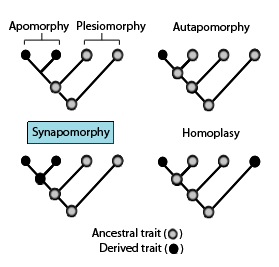Synapomorphy facts for kids

A synapomorphy (say "sin-uh-PO-mor-fee") is a special feature that two or more living things share. It means they got this feature from a shared ancestor who first developed it. Scientists use this idea in a field called cladistics, which is about grouping living things based on their shared history.
Think of it like a unique family heirloom that only certain branches of a family have. This heirloom was first created by a recent ancestor, and it helps you know who belongs to that specific part of the family tree. A synapomorphy is not just any old feature passed down from a very distant ancestor. Instead, it's a newer feature that helps scientists figure out how different groups of living things are related. It helps them build accurate "family trees" for life on Earth.
Contents
What is a Synapomorphy?
A synapomorphy is a shared feature that helps scientists group living things together. This feature must have appeared in the most recent common ancestor of those groups. And, importantly, the ancestors before that common ancestor did not have this feature.
Synapomorphy vs. Other Traits
Not all shared features are synapomorphies. For example, having a backbone is a feature shared by all vertebrates (animals with backbones). But the very first ancestor of all animals with backbones had a backbone. So, a backbone is a shared feature, but it's not a synapomorphy for a smaller group like mammals.
A synapomorphy is a feature that helps us see a new branch on the tree of life. For example, having hair is a synapomorphy for mammals. The common ancestor of all mammals had hair, but the ancestors before that (like the first reptiles) did not. This helps us define the group "mammals."
How Synapomorphies Help Scientists
Scientists use synapomorphies to build phylogenetic trees, which are like family trees for all living things. By finding these unique, shared features, they can:
- Understand how different species are related.
- Group species into natural categories.
- Trace the evolution of new features over time.
For example, the presence of feathers is a synapomorphy for birds. This tells scientists that all birds share a common ancestor who developed feathers. This feature helps to define the entire group of birds.
Images for kids
-
Phylogenies showing how scientists use different kinds of features to understand family trees of living things.
See also
 In Spanish: Sinapomorfia para niños
In Spanish: Sinapomorfia para niños


